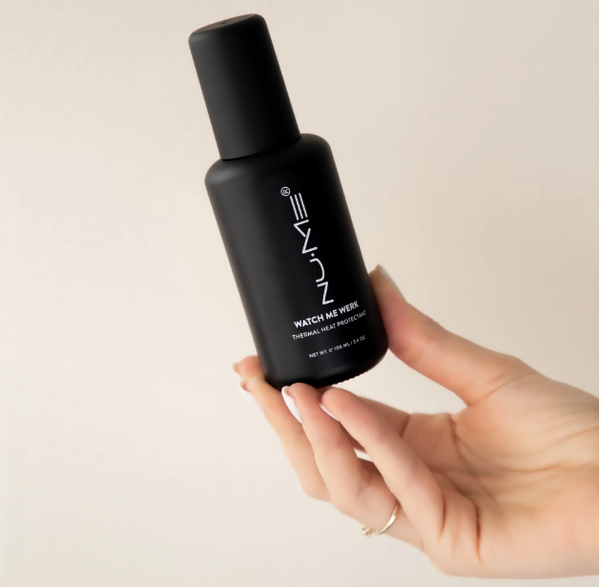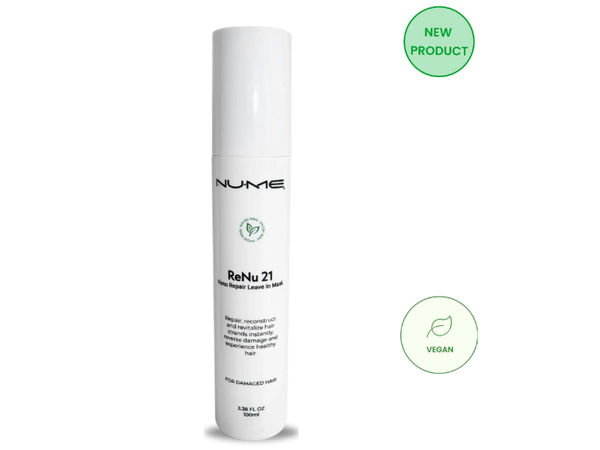
Is 450 Degrees Too Hot For Hair? Tips for Safe Heat Styling
10 min readWhen it comes to styling your hair with heat, is 450 degrees too hot for hair? Take a look at what happens when you curl or straighten your hair at high temperatures.
If you love thermal hair styling as much as we do, you have probably been wondering whether you are doing it at the right temperature to prevent heat-related damage to your hair.
Questions like "Is 450 degrees too hot for hair?" are common and of course, completely reasonable.
In this article, we will answer your most frequent questions about heat styling and temperatures to ensure that you are not inflicting damage on your beautiful mane.
So, without further ado, let's get right into it:
Is 450 degrees too hot for hair?
Yes, 450 degrees Fahrenheit (230 degrees Celsius) is generally considered too hot for thermal heat styling. High temperatures can be detrimental to hair without taking the right measures because they can lead to protein damage, moisture loss, cuticle damage, and structural changes.
On the good side, there are a few things that you can do to mitigate damage and minimize risk - such as using a tourmaline-plated flat iron, applying a thermal heat protectant, and using your heat styling tool at lower temperatures whenever possible. But more on that later!

How does heat damage hair?
Heat damages hair by denaturing its protein structure (keratin), making it weak and brittle. High temperatures can also lead to moisture loss, resulting in dryness and reduced elasticity. In addition, the outer cuticle layer can lift, causing frizz and exposing the inner layers to damage.
When you style your hair at 450 degrees and other high temperatures, a few things happen that can be damaging to the overall health of your mane. Now that you have the short answer, let's take a deeper look:
- Protein damage - hair is primarily composed of a protein called keratin. Excessive heat can break down the protein structure, leading to weakened and damaged hair strands.
- Moisture loss - high temperatures can strip away the natural moisture from the hair. This makes it more prone to dryness, frizz, and an overall lack of luster. Loss of moisture can also affect the elasticity of the hair, making it more susceptible to breakage.
- Cuticle damage - the outer layer of the hair shaft, called the cuticle, plays a crucial role in protecting the inner layers. High temperatures can cause the cuticle to lift, exposing the delicate inner layers of the hair to environmental damage and further moisture loss.
- Structural changes - prolonged exposure to high temperatures can lead to changes in the structure of the hair shaft. This may manifest as split ends, brittleness, and an overall decrease in the hair's ability to withstand stress and styling.
- Color fading - for individuals with color-treated hair, high temperatures can accelerate color fading. The heat opens up the hair cuticle, allowing the color molecules to escape more easily.
How long does heat damage last?
The duration of heat damage varies depending on the severity of the damage and the time you went without addressing it. For example, minor damages like dryness or frizz can be improved with proper care.
On another hand, more severe damage - including breakage and split ends, is irreversible and requires trimming.
For this reason, we highly recommend taking preventive measures, as well as providing proper care for your hair to maintain its long-term health.
How can I prevent heat damage?
If you want to get all the details based on the goals you have with your thermal hair styling, we recommend the following articles:
Otherwise, here are a few of our most important tips:
1. Invest in a flat iron or a curling wand with tourmaline plates
Heat styling tools made from the gemstone tourmaline can help prevent heat damage due to their ability to produce negative ions (thanks to the mineral).
These ions help seal the hair cuticle, reducing frizz and locking in moisture - lack of moisture, as we just saw, is one of the main ways hair gets damaged when being styled in high temperatures.
Additionally, tourmaline-infused plates promote smoother gliding, reducing the need for multiple passes and further decreasing heat exposure.
We recommend the NuMe Megastar Flat Iron and the NuMe Automatic Curling Wand if you are looking to get effortless results without damage.
2. Apply a thermal heat protectant before styling
Applying a thermal heat protectant before styling is an absolute must if you are looking to minimize the damage caused by high temperatures. So, now that you know that 450 degrees is too hot for styling hair, keep in mind that this step will be essential.
Thermal heat protectants form a barrier on the hair shaft, shielding it from the direct impact of high temperatures during styling. They act as a protective layer, preventing excessive moisture loss and protein damage.
By creating this barrier, heat protectants reduce the risk of thermal stress on the hair, minimizing dryness, brittleness, and split ends. We recommend the NuMe Watch Me Werk Thermal Heat Protectant for the most optimal results.
3. Avoid excessive heat styling
If you are looking to minimize heat damage, limit heat styling to 1-2 times per week. Giving your hair breaks between styling sessions will give it time to recover and mitigate risks.
That's because prolonged and excessively frequent heat exposure can damage the protective cuticle layer, causing hair to become weak, dull, and frizzy. Getting rid of frizzy hair, especially if it's caused by heat damage, can be challenging!
In addition, frequent heat styling also often leads to split ends, which can make hair look unhealthy and hinder its growth.
4. Opt for lower temperatures whenever possible
So, we already know that 450 degrees is too hot for hair - but sometimes, depending on your hair type and texture, it can be a good temperature for achieving optimal results. This is especially true if you have thick curly hair.
However, if it's not necessary, opting for lower temperatures whenever possible can be a good way to avoid unnecessary damage inflicted on your hair. For example, if you have fine or chemically treated hair, you can get good results on as little as 200 °F (200 °C).
For this reason, it's essential to invest in a flat iron with temperature control settings such as the award-winning NuMe Megastar Flat Iron. This will allow you to have more control over your heat styling, and minimize damage as a result.
You can read more on the best temperatures for thermal heat styling here.
5. Incorporate deep conditioning treatments
Another way to mitigate damage from heat styling is to incorporate a deep conditioning treatment into your hair care routine. Deep conditioning treatments provide intense moisture and nourishment to your hair, helping to counteract the dryness caused by heat styling.
They often contain ingredients like hydrating oils, proteins, and vitamins that penetrate the hair shaft, restoring moisture and strengthening the protein structure.
This added hydration and fortification make your hair more resilient to the damaging effects of heat, reducing the risk of brittleness, breakage, and split ends.
Regular deep conditioning can improve overall hair health, making it more resistant to the stresses of heat styling and promoting a smoother, shinier appearance.
We recommend the NuMe Vegan Tourmaline Hair Mask for optimal results with your deep conditioning treatment. Infused with tourmaline powder, argan oil, and parkii butter, this hair mask made with all-natural ingredients enhances elasticity and flexibility without leaving your home.
6. Avoid ironing wet hair
One of the biggest mistakes we often see when it comes to thermal heat styling is ironing wet hair. Yes, we know that life is short and you are constantly on the go, but don't ignore the damage that can be caused by not taking the time to dry your hair first after washing.
If you are not convinced yet, let's take a deeper look:
- Hair damage - hair is in its most vulnerable state when it's wet, which means that high temperatures can cause severe damage to the hair structure, such as cuticle damage and cortex alteration. Heat styling on wet hair can also lead to moisture loss, which is essential for the flexibility and the strength of the hair.
- Steam damage - another thing to keep in mind when it comes to heat styling wet hair is steam damage. So, what does this mean exactly? Well, the heat converts water in wet hair into steam, which can cause hair cuticles to crack, leading to brittle, frizzy, and damaged hair.
- Increased breakage - due to its increased vulnerability and elasticity in wet state, hair tends to be more prone to breakage. Applying high heat to it can lead to excessive breakage and split ends, and we are sure that's not what you want for your hair!
On top of damage, ironing wet hair can generally be more ineffective when it comes to styling, and you may not like the final result of your efforts (talk about "saving time!"). You also risk burning your scalp or hands, which is not to be underestimated.
So, still wondering if 450 degrees is too hot for hair?
7. Use a repair mask
If you are looking to reap the benefits of thermal heat styling without damage, we highly recommend using a repair mask, such as the NuMe ReNu21 Nano Repair Leave in Mask.
Formulated with 21 amino acids, this awesome mask helps reconstruct damaged hair and reconnect broken bonds by mimicking hair structure. The result are shiny, flourishing, and shiny hair strands - the results are almost instant, and your hair will improve with each use.
FAQ
Can heat damage be repaired?
Minor heat damage, like dryness, can be improved with deep conditioning and proper care. However, severe damage, such as split ends, is irreversible and requires trimming.
Consistent healthy practices aid recovery, but prevention remains crucial for long-term hair health.
How do I know if I have heat damage?
Signs of heat damage include dryness, frizz, split ends, and brittle texture. Hair might lack elasticity and shine. If your strands break easily or don't bounce back when stretched, it's likely damaged.
Regular deep conditioning and trimming can help revive health and manageability.
Can I get my curls back after heat damage?
Yes, you can reclaim your curls after heat damage. Trim the damaged ends, focus on deep conditioning to restore moisture, and avoid heat styling. Embrace natural curls, and use styling techniques like twist-outs or braids to enhance curl pattern.
Patience and consistent care will help revive your curls over time.
Is 400 degrees too hot for curly hair?
Yes, 400 degrees is too hot for curly hair. Curly hair is more prone to dryness and damage. Stick to lower temperatures whenever possible, around 300-350 degrees, to style without causing harm.
Use a heat protectant and prioritize the health of your curls to prevent excessive heat damage.
Is 300 degrees too hot for hair?
No, 300 degrees is generally safe for hair, but use a heat protectant. It's a moderate temperature that allows effective styling while minimizing the risk of damage. Adjust based on your hair type and condition, and always prioritize protection and care.
Can heat damage thin hair?
Yes, heat can damage thin hair. Thin hair is more vulnerable, and excessive heat can lead to breakage, dryness, and reduced volume. Use lower temperatures, employ heat protectants, and avoid frequent styling to protect thin hair from potential damage.












